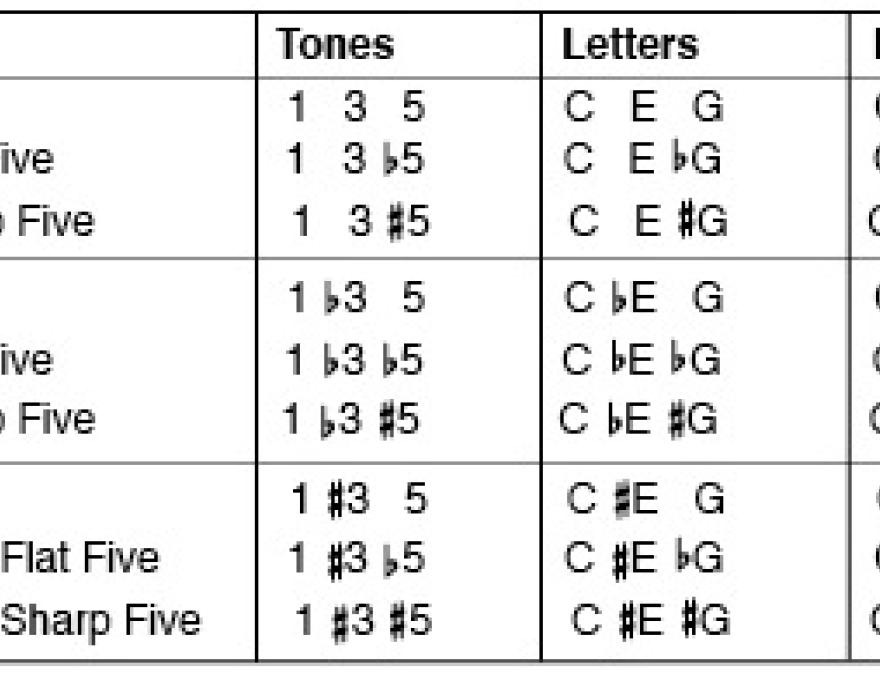by Mike Overly
There are many systems used to notate harmony, whether that harmony is an interval, an arpeggio, or a chord. For example, orchestral music uses staff notation, harmonic analysis uses Roman numerals, and the Baroque era used figured bass. However, the most popular harmony symbol used in today's music is the macro symbol, more simply known as a "chord symbol."
Simply stated, a harmony symbol consists of two parts: the Letter of the harmony and the Type. And although these symbols are seldom used in classical music, they are universally used to specify the harmony of popular music as found in lead sheets, fake books and chord charts. Therefore, a clear and simple understanding of harmony symbolization is essential.
A quick internet search of harmony symbol notation will present you with an overwhelming amount of confusing, incomplete and, dare I say it, wrong information. So, let's clean the slate, start at the beginning and discover that harmony notation isn't overwhelming or confusing at all.
For the examples used in this lesson, we will use the C major scale. Let's begin by presenting the C major scale as seven letters and seven tone numbers, also known as scale degrees. In the first octave they are 1C 2D 3E 4F 5G 6A 7B, and in the second octave they become 8C 9D 10E 11F 12G 13A 14B. Now, the first thing we need to realize about harmony is that harmony begins with one sound! To many this just doesn't seem correct, but it is.
Think of it this way. If we were to begin with a complex harmony symbol, say C major 13, which contains the letters and tones 1C 3E 5G 7B 9D 11F 13A, we would probably quit because as a beginner, that's a frightening chord! However, if we were to "reduce" this complex harmony by deleting six tones and letters, then, only one tone and letter would remain: 1C. And that isn't complex at all. In fact, it's very simple. Now you can understand that harmony, no matter how complex, begins with one sound, one letter and one tone number. Let's continue.
Harmony of two sounds is called an interval. An interval contain two letters and two tone numbers. For this lesson, we will begin with the following intervals: Perfect Fifth: natural 5, the Diminished Fifth: flat 5, and the Augmented Fifth: sharp 5.
The Perfect Fifth, P5, is simply the fifth sound of the major scale, tone 5 letter G. And when the perfect fifth is combined with the first sound of the scale, tone 1 letter C, the perfect fifth interval is the result. The perfect fifth interval may be played melodically, which means one at a time, or, harmonically, which means at the same time. Now, to understand the next two intervals, a simple understanding of flat (b) and sharp (#) is necessary. On guitar, flat is one fret lower from any letter or tone number, and sharp is one fret higher from any letter or tone number. That was easy!
Diminished means to shrink or make smaller. Therefore, the diminished fifth is simply the fifth sound of the major scale flatted, tone b5 letter bG. And when the diminished fifth, b5 bG is combined with tone 1 letter C, the diminished fifth interval is the result. The diminished fifth interval may be played melodically or harmonically.
Augmented means to expand or make larger. Therefore, the augmented fifth is simply the fifth sound of the major scale sharped, tone #5 letter #G. And when the augmented fifth, #5 #G is combined with tone 1 letter C, the augmented fifth interval is the result. The augmented fifth interval may also be played melodically or harmonically.
Now, let's present the three intervals based on tone 3 letter E. They are Major: natural 3, Minor: flat 3 and Suspended: sharp 3. You will notice that even though we used the flat and sharp signs with third intervals, we did not use the designation diminished and augmented!
The Major Third, M3, is simply the third sound of the major scale, tone 3 letter E. When the major third is combined with the first sound of the scale, tone 1 letter C, the major third interval is the result. The major third interval may be played melodically or harmonically.
The Minor Third, m3, is simply the third sound of the major scale flatted, tone b3 letter bE. And when the minor third is combined with the first sound of the scale, tone 1 letter C, the minor third interval is the result. The minor third interval may be played melodically or harmonically.
The Suspended Third, sus3, is simply the third sound of the major scale sharped, tone #3 letter #E. And when the major third is combined with the first sound of the scale, tone 1 letter C, the suspended third interval is the result. The suspended third interval may also be played melodically or harmonically.
One more thought. The definition of enharmonic is one sound with more than one symbol. Therefore, it's important to point out that tone #3 letter #E sounds like tone 4 letter F, but they are two different symbols. See page 102 of Guitar Fretboard Facts for further clarification of this important concept. <http://www.12tonemusic.com/guitar/facts/>
Okay, it's now time to use the above information to create Nine Triads of Three Types.
Tri is Greek for three. Therefore, triads are arpeggio and chord harmonies which are spelled with three different letters and three different tone numbers. Here's the essential point, there are only nine triads upon which all arpeggios and chords are based. These nine triads are created by combining three types of thirds: major, minor and suspended, with three types of fifths: perfect, diminished and augmented. In the following examples, C is tone 1, which is also known as the root, tonic and the fundamental.
 Here is something very important. Notice that the type symbol for major is nothing. In other words, there is a harmony letter for major, but there is no harmony symbol for major. Said a different way, when you see nothing, and yes, you can see nothing, it means something, and in this case, when you see no type symbol after the harmony letter, it means major! Here's another way of saying this, when reading the harmony symbol C, you think and say C major!
Here is something very important. Notice that the type symbol for major is nothing. In other words, there is a harmony letter for major, but there is no harmony symbol for major. Said a different way, when you see nothing, and yes, you can see nothing, it means something, and in this case, when you see no type symbol after the harmony letter, it means major! Here's another way of saying this, when reading the harmony symbol C, you think and say C major!
You will also notice that each of the nine triads only have one Type, one Name, one Tone Spelling and one Letter Spelling. However, since there is no standardization of harmony symbolism, some of the nine triads have more than one Harmony Symbol. This really shouldn't be the case because, more often than not, it leads to confusion. But, oh well, that's the way it is.
So, 'til next time, have some nine triad fun… I'll be listening!
And don't forget to drop me a line at <frets@12tonemusic.com> to let me know if you liked this lesson or not.
Globally-renowned guitar and bass instructor, Mike Overly easily combines the worlds of deeply-rooted academic study with a well-textured performance resume. His pathbreaking 12 Tone Music Publishing products, including the newly released "Tone Note® Music Method for Guitar," provide valuable illuminating insights while simplifying the learning process.
Join Mike at www.12tonemusic.com to explore and expand your knowledge of these two iconic instruments through a variety of reviews and interviews, tips and tricks and free lessons of remarkable originality, all presented in a family-friendly forum. Plus, as an added bonus, you get to follow Mr. Pick as he introduces you to fun fretboard games, jokes, riddles, quotes and more. Be sure to read the 12 Tone Music Blog where Mike offers a behind-the-scenes look at the development of his unique approach to solving the problems of modern musical notation and traditional guitar and bass methods.
Mike Overly's unmatched perspective on fretboard education has something for everyone ~ from the amateur hobbyist to the serious professional player ~ as well as any music enthusiast who wants to come along for the ride.
There are many systems used to notate harmony, whether that harmony is an interval, an arpeggio, or a chord. For example, orchestral music uses staff notation, harmonic analysis uses Roman numerals, and the Baroque era used figured bass. However, the most popular harmony symbol used in today's music is the macro symbol, more simply known as a "chord symbol."
Simply stated, a harmony symbol consists of two parts: the Letter of the harmony and the Type. And although these symbols are seldom used in classical music, they are universally used to specify the harmony of popular music as found in lead sheets, fake books and chord charts. Therefore, a clear and simple understanding of harmony symbolization is essential.
A quick internet search of harmony symbol notation will present you with an overwhelming amount of confusing, incomplete and, dare I say it, wrong information. So, let's clean the slate, start at the beginning and discover that harmony notation isn't overwhelming or confusing at all.
For the examples used in this lesson, we will use the C major scale. Let's begin by presenting the C major scale as seven letters and seven tone numbers, also known as scale degrees. In the first octave they are 1C 2D 3E 4F 5G 6A 7B, and in the second octave they become 8C 9D 10E 11F 12G 13A 14B. Now, the first thing we need to realize about harmony is that harmony begins with one sound! To many this just doesn't seem correct, but it is.
Think of it this way. If we were to begin with a complex harmony symbol, say C major 13, which contains the letters and tones 1C 3E 5G 7B 9D 11F 13A, we would probably quit because as a beginner, that's a frightening chord! However, if we were to "reduce" this complex harmony by deleting six tones and letters, then, only one tone and letter would remain: 1C. And that isn't complex at all. In fact, it's very simple. Now you can understand that harmony, no matter how complex, begins with one sound, one letter and one tone number. Let's continue.
Harmony of two sounds is called an interval. An interval contain two letters and two tone numbers. For this lesson, we will begin with the following intervals: Perfect Fifth: natural 5, the Diminished Fifth: flat 5, and the Augmented Fifth: sharp 5.
The Perfect Fifth, P5, is simply the fifth sound of the major scale, tone 5 letter G. And when the perfect fifth is combined with the first sound of the scale, tone 1 letter C, the perfect fifth interval is the result. The perfect fifth interval may be played melodically, which means one at a time, or, harmonically, which means at the same time. Now, to understand the next two intervals, a simple understanding of flat (b) and sharp (#) is necessary. On guitar, flat is one fret lower from any letter or tone number, and sharp is one fret higher from any letter or tone number. That was easy!
Diminished means to shrink or make smaller. Therefore, the diminished fifth is simply the fifth sound of the major scale flatted, tone b5 letter bG. And when the diminished fifth, b5 bG is combined with tone 1 letter C, the diminished fifth interval is the result. The diminished fifth interval may be played melodically or harmonically.
Augmented means to expand or make larger. Therefore, the augmented fifth is simply the fifth sound of the major scale sharped, tone #5 letter #G. And when the augmented fifth, #5 #G is combined with tone 1 letter C, the augmented fifth interval is the result. The augmented fifth interval may also be played melodically or harmonically.
Now, let's present the three intervals based on tone 3 letter E. They are Major: natural 3, Minor: flat 3 and Suspended: sharp 3. You will notice that even though we used the flat and sharp signs with third intervals, we did not use the designation diminished and augmented!
The Major Third, M3, is simply the third sound of the major scale, tone 3 letter E. When the major third is combined with the first sound of the scale, tone 1 letter C, the major third interval is the result. The major third interval may be played melodically or harmonically.
The Minor Third, m3, is simply the third sound of the major scale flatted, tone b3 letter bE. And when the minor third is combined with the first sound of the scale, tone 1 letter C, the minor third interval is the result. The minor third interval may be played melodically or harmonically.
The Suspended Third, sus3, is simply the third sound of the major scale sharped, tone #3 letter #E. And when the major third is combined with the first sound of the scale, tone 1 letter C, the suspended third interval is the result. The suspended third interval may also be played melodically or harmonically.
One more thought. The definition of enharmonic is one sound with more than one symbol. Therefore, it's important to point out that tone #3 letter #E sounds like tone 4 letter F, but they are two different symbols. See page 102 of Guitar Fretboard Facts for further clarification of this important concept. <http://www.12tonemusic.com/guitar/facts/>
Okay, it's now time to use the above information to create Nine Triads of Three Types.
Tri is Greek for three. Therefore, triads are arpeggio and chord harmonies which are spelled with three different letters and three different tone numbers. Here's the essential point, there are only nine triads upon which all arpeggios and chords are based. These nine triads are created by combining three types of thirds: major, minor and suspended, with three types of fifths: perfect, diminished and augmented. In the following examples, C is tone 1, which is also known as the root, tonic and the fundamental.

You will also notice that each of the nine triads only have one Type, one Name, one Tone Spelling and one Letter Spelling. However, since there is no standardization of harmony symbolism, some of the nine triads have more than one Harmony Symbol. This really shouldn't be the case because, more often than not, it leads to confusion. But, oh well, that's the way it is.
So, 'til next time, have some nine triad fun… I'll be listening!
And don't forget to drop me a line at <frets@12tonemusic.com> to let me know if you liked this lesson or not.
Globally-renowned guitar and bass instructor, Mike Overly easily combines the worlds of deeply-rooted academic study with a well-textured performance resume. His pathbreaking 12 Tone Music Publishing products, including the newly released "Tone Note® Music Method for Guitar," provide valuable illuminating insights while simplifying the learning process.
Join Mike at www.12tonemusic.com to explore and expand your knowledge of these two iconic instruments through a variety of reviews and interviews, tips and tricks and free lessons of remarkable originality, all presented in a family-friendly forum. Plus, as an added bonus, you get to follow Mr. Pick as he introduces you to fun fretboard games, jokes, riddles, quotes and more. Be sure to read the 12 Tone Music Blog where Mike offers a behind-the-scenes look at the development of his unique approach to solving the problems of modern musical notation and traditional guitar and bass methods.
Mike Overly's unmatched perspective on fretboard education has something for everyone ~ from the amateur hobbyist to the serious professional player ~ as well as any music enthusiast who wants to come along for the ride.






